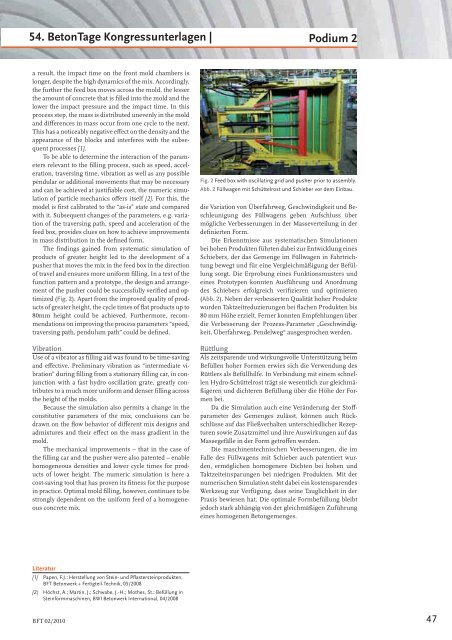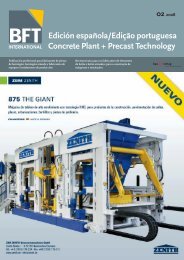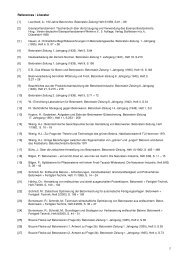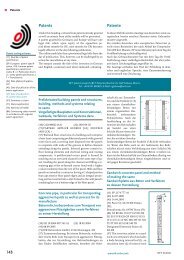Concrete Plant + Precast Technology Betonwerk ... - BFT International
Concrete Plant + Precast Technology Betonwerk ... - BFT International
Concrete Plant + Precast Technology Betonwerk ... - BFT International
Sie wollen auch ein ePaper? Erhöhen Sie die Reichweite Ihrer Titel.
YUMPU macht aus Druck-PDFs automatisch weboptimierte ePaper, die Google liebt.
54. BetonTage Kongressunterlagen |<br />
a result, the impact time on the front mold chambers is<br />
longer, despite the high dynamics of the mix. Accordingly,<br />
the further the feed box moves across the mold, the lesser<br />
the amount of concrete that is fi lled into the mold and the<br />
lower the impact pressure and the impact time. In this<br />
process step, the mass is distributed unevenly in the mold<br />
and diff erences in mass occur from one cycle to the next.<br />
This has a noticeably negative eff ect on the density and the<br />
appearance of the blocks and interferes with the subsequent<br />
processes [1].<br />
To be able to determine the interaction of the parameters<br />
relevant to the fi lling process, such as speed, acceleration,<br />
traversing time, vibration as well as any possible<br />
pendular or additional movements that may be necessary<br />
and can be achieved at justifi able cost, the numeric simulation<br />
of particle mechanics off ers itself [2]. For this, the<br />
model is fi rst calibrated to the “as-is” state and compared<br />
with it. Subsequent changes of the parameters, e.g. variation<br />
of the traversing path, speed and acceleration of the<br />
feed box, provides clues on how to achieve improvements<br />
in mass distribution in the defi ned form.<br />
The fi ndings gained from systematic simulation of<br />
products of greater height led to the development of a<br />
pusher that moves the mix in the feed box in the direction<br />
of travel and ensures more uniform fi lling. In a test of the<br />
function pattern and a prototype, the design and arrangement<br />
of the pusher could be successfully verifi ed and optimized<br />
(Fig. 2). Apart from the improved quality of products<br />
of greater height, the cycle times of fl at products up to<br />
80mm height could be achieved. Furthermore, recommendations<br />
on improving the process parameters “speed,<br />
traversing path, pendulum path” could be defi ned.<br />
Vibration<br />
Use of a vibrator as fi lling aid was found to be time-saving<br />
and eff ective. Preliminary vibration as “intermediate vibration”<br />
during fi lling from a stationary fi lling car, in conjunction<br />
with a fast hydro oscillation grate, greatly contributes<br />
to a much more uniform and denser fi lling across<br />
the height of the molds.<br />
Because the simulation also permits a change in the<br />
constitutive parameters of the mix, conclusions can be<br />
drawn on the fl ow behavior of diff erent mix designs and<br />
admixtures and their eff ect on the mass gradient in the<br />
mold.<br />
The mechanical improvements – that in the case of<br />
the fi lling car and the pusher were also patented – enable<br />
homogeneous densities and lower cycle times for products<br />
of lower height. The numeric simulation is here a<br />
cost-saving tool that has proven its fi tness for the purpose<br />
in practice. Optimal mold fi lling, however, continues to be<br />
strongly dependent on the uniform feed of a homogeneous<br />
concrete mix.<br />
Literatur<br />
[1] Papen, F.J.: Herstellung von Stein- und Pfl astersteinprodukten,<br />
<strong>BFT</strong> <strong>Betonwerk</strong> + Fertigteil-Technik, 05/2008<br />
[2] Höchst, A.; Martin, J.; Schwabe, J.-H.; Mothes, St.: Befüllung in<br />
Steinformmaschinen, BWI <strong>Betonwerk</strong> <strong>International</strong>, 04/2008<br />
<strong>BFT</strong> 02/2010<br />
Podium 2<br />
Fig. 2 Feed box with oscillating grid and pusher prior to assembly.<br />
Abb. 2 Füllwagen mit Schüttelrost und Schieber vor dem Einbau.<br />
die Variation von Überfahrweg, Geschwindigkeit und Beschleunigung<br />
des Füllwagens geben Aufschluss über<br />
mögliche Verbesserungen in der Masseverteilung in der<br />
defi nierten Form.<br />
Die Erkenntnisse aus systematischen Simulationen<br />
bei hohen Produkten führten dabei zur Entwicklung eines<br />
Schiebers, der das Gemenge im Füllwagen in Fahrtrichtung<br />
bewegt und für eine Vergleichmäßigung der Befüllung<br />
sorgt. Die Erprobung eines Funktionsmusters und<br />
eines Prototypen konnten Ausführung und Anordnung<br />
des Schiebers erfolgreich verifi zieren und optimieren<br />
(Abb. 2). Neben der verbesserten Qualität hoher Produkte<br />
wurden Taktzeitreduzierungen bei fl achen Produkten bis<br />
80 mm Höhe erzielt. Ferner konnten Empfehlungen über<br />
die Verbesserung der Prozess-Parameter „Geschwindigkeit,<br />
Überfahrweg, Pendelweg“ ausgesprochen werden.<br />
Rüttlung<br />
Als zeitsparende und wirkungsvolle Unterstützung beim<br />
Befüllen hoher Formen erwies sich die Verwendung des<br />
Rüttlers als Befüllhilfe. In Verbindung mit einem schnellen<br />
Hydro-Schüttelrost trägt sie wesentlich zur gleichmäßigeren<br />
und dichteren Befüllung über die Höhe der Formen<br />
bei.<br />
Da die Simulation auch eine Veränderung der Stoff -<br />
parameter des Gemenges zulässt, können auch Rückschlüsse<br />
auf das Fließverhalten unterschiedlicher Rezepturen<br />
sowie Zusatzmittel und ihre Auswirkungen auf das<br />
Massegefälle in der Form getroff en werden.<br />
Die maschinentechnischen Verbesserungen, die im<br />
Falle des Füllwagens mit Schieber auch patentiert wurden,<br />
ermöglichen homogenere Dichten bei hohen und<br />
Taktzeiteinsparungen bei niedrigen Produkten. Mit der<br />
numerischen Simulation steht dabei ein kostensparendes<br />
Werkzeug zur Verfügung, dass seine Tauglichkeit in der<br />
Praxis bewiesen hat. Die optimale Formbefüllung bleibt<br />
jedoch stark abhängig von der gleichmäßigen Zuführung<br />
eines homogenen Betongemenges.<br />
47












